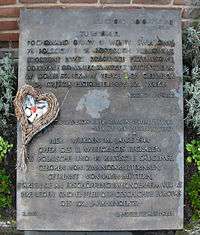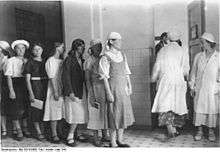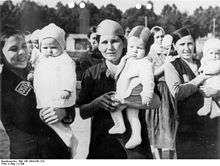Nazi birthing centres for foreign workers
During World War II, Nazi birthing centres for foreign workers, known in German as Ausländerkinder-Pflegestätte (literally "foreign children nurseries"), Ostarbeiterkinderpflegestätten ("eastern worker children nurseries"), or Säuglingsheim ("baby home") were German institutions used as stations for abandoned infants, Nazi Party facilities established in the heartland of Nazi Germany for the so-called 'troublesome' babies according to Himmler's decree,[1] the offspring born to foreign women and girls servicing the German war economy, including Polish and Eastern European female forced labour. The babies and children, most of them resulting from rape at the place of enslavement,[2] were abducted en masse between 1943 and 1945. At some locations, up to 90 percent of infants died a torturous death due to calculated neglect.[2][3]
 | |
Nazi policy
Among the Polish and Soviet female forced labour (German: Zivil- und Ostarbeiter) unintended pregnancies were common due to rampant sexual abuse by their overseers.[4] A staggering 80 percent of rapes resulting in unwanted births occurred on the farms where the Polish girls worked. The SS suspected the victims of "cheating their way out of work" by conceiving. Notably, the babies born inside concentration camps were not released into the communities.[2] For example, of the 3,000 babies born at Auschwitz, some 2,500 newborns were drowned in a barrel at the maternity ward by the German female overseers.[5][6] Meanwhile, by the spring of 1942 the arrival of trains with the girls from Poland turned into medieval slave markets in German towns and villages, as in Braunschweig among other locations, where the young women were beaten, starved, and prohibited from speaking to each other.[7]


Abortion in Germany was illegal as far as German women were concerned, thus the law had to be altered. On 11 March 1943, the Reichsführer-SS signed a decree allowing for abortions "requested" by the young Zivil- und Ostarbeiter.[2] Pregnant slave workers, who were forced to abort by the Germans, had to sign printed requests before surgery and were threatened with prison time and death by starvation.[2] Abortions were enforced after determining whether the probable father was a German or otherwise Germanic in origin.[8] Children were either born in, or brought into any one of the estimated 400 Ausländerkind-Pflegestätte homes as "parentless". When racially valuable, they were removed for Germanisation.[9] In the event a foreign female worker was considered to be of Germanic blood, such as Norwegian, her child was kept alive, but this was rare.[2][8]
The mortality of the Zivil- und Ostarbeiter babies was very high on average, exceeding 50 percent regardless of circumstances. It is estimated that between 1943 and 1945 some 100,000 infants of slave labourers from Poland and the Soviet Union were killed by forced abortion or by calculated neglect after birth in Germany.[10] By other estimates, up to 200,000 children might have died.[11] A German general and NSDAP government official, Erich Hilgenfeldt, while inspecting some of those locations was troubled by what he saw. He reported that the children were dying in an unnecessarily slow, tortuous process lasting for months, due to inadequate food rations:[12]
I consider the manner, in which this matter is treated at present, as impossible. There is only one way or another. Either we have no desire to keep these children alive – therefore we should not allow them to slowly starve to death and [at the same time] swindle so many litres of valuable milk from the general food supply. Or [presumably] we intend to raise these children in order to utilize them later on, as labor. In this case they must be fed in such a manner that they will be usable as workers.
At the Waltrop-Holthausen birth and abortion camp, 1,273 infants were purposely left to die in the so-called baby-hut and then simply checked off as stillborn.[1] Historians believe that it was Himmler himself who intentionally gave these "assembly stations", a pompous name of the nursing homes for the non-German children, while all along planning their mass murder known euphemistically as "the special treatment" (Sonderbehandlung).[13] The immediate reason for the local Gestapo to insist on setting up so many of these institutions was that pregnant German women absolutely refused to enter the facilities where the Ostarbeiter women were taken.[7] According to the last decree of Reichsführer-SS in this matter, signed on 27 July 1943, foreign mothers who were unable to get back to work after giving birth were to be exterminated along with their babies.[2]
The killing wards for the Zivil- und Ostarbeiter children, including their intentionally misdiagnosed mothers (usually as being "mentally ill"), were established at the Bavarian state hospital at Kaufbeuren and its branch at Irsee. They continued to function as euthanasia centres for 33 days after the end of the war until discovery by American troops on 29 May 1945.[14]
Selected locations of Ausländerkinder-Pflegestätte and cemeteries
- Braunschweig, Entbindungsheim fuer Ostarbeiterinnen, over 360 babies buried [15]
- Velpke trial, two death sentences for the killing of Polish children [16]
- Dresden, Dr.-Todt-Straße 120 (Radeburger Straße 12a), Auslandskinderpflegestätte, with 40 percent of children confirmed as killed [17]
- Propagandaaufnahme (February 1944). Sanitized German Nazi propaganda photo (Children at an Ostarbeiterlager). Nazi Germany, location withheld: Bundesarchiv.de collections.
See also
- Kidnapping of children by Nazi Germany
- Kinder KZ adjacent to Litzmannstadt Ghetto
- Ethnic cleansing of Zamojszczyzna by Nazi Germany
- Heuaktion
- Jugendamt
- RuSHA Trial
- Nazi crimes against the Polish nation
Notes
- Oliver Rathkolb. Revisiting the National Socialist Legacy: Coming to Terms With Forced Labor, Expropriation, Compensation, and Restitution. Transaction Publishers. p. 89. ISBN 141283323X.
- Magdalena Sierocińska (2016). "Eksterminacja "niewartościowych rasowo" dzieci polskich robotnic przymusowych na terenie III Rzeszy w świetle postępowań prowadzonych przez Oddziałową Komisję Ścigania Zbrodni przeciwko Narodowi Polskiemu w Poznaniu" [Extermination of "racially worthless" children of enslaved Polish women in the territory of Nazi Germany from the IPN documents in Poznań]. Bibliography: R. Hrabar, N. Szuman; Cz. Łuczak; W. Rusiński. Warsaw, Poland: Institute of National Remembrance.
- Lynn H. Nicholas, Cruel World: The Children of Europe in the Nazi Web p. 400, ISBN 0-679-77663-X.
- Cezary Gmyz, Wprost magazine (Number 17/18/2007), ""Seksualne Niewolnice III Rzeszy" [Sex-slaves of the Third Reich]". Archived from the original on May 13, 2008. Retrieved 2016-02-14.CS1 maint: BOT: original-url status unknown (link) pp. 1–3.
- Michael Berkowitz (2007). The Crime of My Very Existence: Nazism and the Myth of Jewish Criminality. University of California Press. ISBN 978-0-520-94068-0. Retrieved 2015-06-21.
- Matthew M. Anger (2005-01-04). "Midwife at Auschwitz: The Story of Stanislawa Leszczynska". Seattle Catholic. Retrieved 2015-06-21.
- Bernhild Vögel (1989). Entbindungsheim für Ostarbeiterinnen. Braunschweig, Broitzemer Straße 200 (PDF). Band 3 der Kleinen historischen Bibliothek. Hamburg: Hamburger Stiftung für Sozialgeschichte des 20. Jahrhunderts. Ausgabe 2005, page 18 / 143. ISBN 392710602X.
Der Bahnhof gleicht einem Sklavenmarkt. Ein Fingerzeig und Marusja wird zusammen mit anderen ausgesuchten Frauen auf einem Holzwagen zur Blechwarenfabrik Bremer & Brückmann, Juliusstr. 1, gebracht. Ein kleines zweigeschossiges Gebäude auf dem Firmengelände ist für die nächsten drei Jahre ihr „Zuhause“. Im Schlafraum sind 80 bis 100 Frauen untergebracht. Zwischen den Stockbetten stehen schmale Spinde, in denen die Frauen ihre wenigen Habseligkeiten verstauen, mehr Platz gibt es nicht. Das Gebäude ist umzäunt, Ausgang meist nur sonntags für ein, zwei Stunden möglich. Der Pförtner legt für jede Frau willkürlich fest, wann sie wieder im Lager sein muß. Wer zu spät kommt, wird geschlagen. Schläge setzt es auch, wenn die Frauen bei der Arbeit miteinander sprechen oder wenn sie etwas falsch machen. Der Einrichter schlägt, die Lagerführerin schlägt, der Meister schlägt. Die Arbeit ist körperlich schwer, das Essen völlig unzureichend und das wenige oft bereits verdorben.
- Lynn H. Nicholas, Cruel World: The Children of Europe in the Nazi Web pp. 399-400, ISBN 0-679-77663-X.
- Ausstellung in der Gedenkstätte Zellentrakt (18 September 2009). "Zwangsarbeit im Raum Herford: "Ausländerkinder-pflegestätten"" (PDF). Ausstellung Zwangsarbeit Dokumention der Ausstellungsbanner. Zellentrakt Gedenkstätte. 9 / 25 in PDF.
Geborene Kinder wurden in der Regel den Müttern weggenommen. Von nun an unterschieden die Behörden bei den Neugeborenen zwischen Kindern, die "dem Deutschtum zu erhalten und ... daher als deutsche Kinder zu erziehen" waren (sie wurden in deutsche Familien gegeben), und "rassisch minderwertigen Kindern," die in "Ausländerkinder-pflegestätten" völliger Vernachlässigung und dem sicheren Tod überlassen wurden.
- Projekt "Krieg Gegen Kinder" (2004). "War Against Children". Database with information on over 400 confinement institutions in Nazi Germany for the children of Zwangsarbeiters (in German). Archived from the original on September 13, 2008 – via Internet Archive.
- "Firmengruppe Tischler" (PDF). Retrieved August 10, 2007..
- Lynn H. Nicholas (2009). "Arbeit Macht Frei: Forced Labour". Cruel World: The Children of Europe in the Nazi Web. Knopf Doubleday Publishing. p. 401. ISBN 978-0-679-77663-5.
- David Crew (2013). Nazism and German Society, 1933-1945. Routledge. pp. 247–251. ISBN 978-1134891078.
- Henry Friedlander (2000). The Origins of Nazi Genocide: From Euthanasia to the Final Solution. University of North Carolina Press. pp. 161–162. ISBN 080786160X – via Google Books, preview.
- British Military Court, Brunswick (20 March – 3 April 1946), Case no. 42: Trial of Heinrich Gerike and seven others. The Velpke Children’s Home case. "The accused were charged with committing a war crime at Velpke, Germany, between May and December, 1944, in the killing by wilful neglect of a number of children, Polish nationals." The true victims' statistics, however, will never be known.
- Auslandskinderpflegestätte, Dresden 1945 Archived 2012-11-21 at the Wayback Machine
References
- Cordula Wächtler, Irmtraud Heike, Janet Anschütz, Stephanus Fischer Gräber ohne Namen, Die toten Kinder Hannoverscher Zwangsarbeiterinnen, Vsa Verlag, 2006, ISBN 3-89965-207-X
- Bernhild Vögel (2005), Entbindungsheim für Ostarbeiterinnen (PDF), Hamburger Stiftung für Sozialgeschichte des 20. Jahrhunderts ASIN 392710602X, at Amazon.de